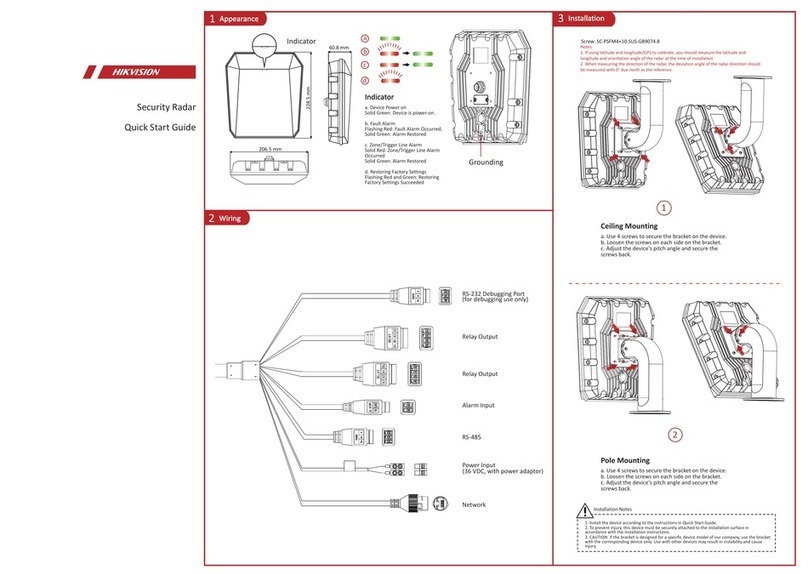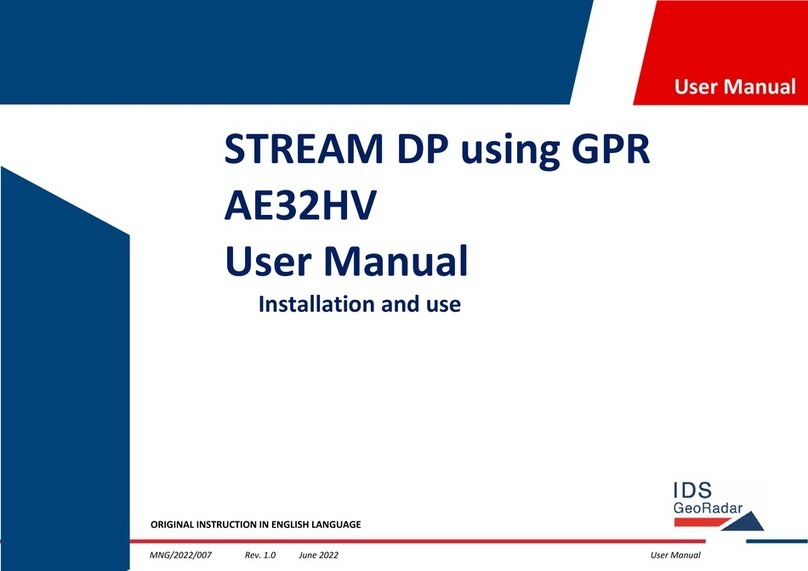Bosch CR5CBCC User manual

Budapest
10 June 2021
From
Our Reference
Tel
XC-DA/ECR3-Bp
Daniel Radics
+36 1 879-6276
Page 1 of 17
CR5CBCC_User_manual.docx
Contents
1 Description of CR5CBCC parts........................................................................................... 2
2 Explanation of CW Radar function ...................................................................................... 3
3 Operation principle of the CR5CBCC.................................................................................. 5
4 User information ................................................................................................................. 5
4.1 General description ..................................................................................................... 5
4.2 Areas of application ..................................................................................................... 6
4.2.1 Blind spot detection .............................................................................................. 6
4.2.2 Lane change assist............................................................................................... 6
4.2.3 Rear Cross Traffic Assist with braking .................................................................. 6
4.2.4 Door opening warning........................................................................................... 6
4.2.5 Rear collision warning........................................................................................... 6
4.2.6 Front Cross Traffic Assist - Information................................................................. 6
5 National statements ............................................................................................................ 7
5.1 Canada........................................................................................................................ 7
5.2 Chinese Warning Statement ........................................................................................ 7
5.3 European Union........................................................................................................... 7
5.4 United Kingdom ........................................................................................................... 7
5.5 United States............................................................................................................... 8
6 Vehicle integration .............................................................................................................. 8
6.1 Radar cone.................................................................................................................. 9
6.2 Fascia design guidelines ........................................................................................... 11
6.3 Installation Hints ........................................................................................................ 12
7 Calibration ........................................................................................................................ 17
8 Technical Data.................................................................................................................. 17
Issue
1.0
Topic
CR5CBCC User Manual
Description
Specific for International Type Approval purposes.
Report

From
Our Reference
Tel
XC-DA/ECR3-Bp
Daniel Radics
+36 1 879-6276
Issue
1.0
Topic
CR5CBCC User Manual
Budapest
10 June 2021
Page 2 of 17
Report
CR5CBCC_User_manual.docx
1Description of CR5CBCC parts
radome
RF absorber
PCB
thermal pads
shield / heatsink
bottom part of housing
with connector
Figure 1: CR5CBCC assembly view
Pressure
compensation element

From
Our Reference
Tel
XC-DA/ECR3-Bp
Daniel Radics
+36 1 879-6276
Issue
1.0
Topic
CR5CBCC User Manual
Budapest
10 June 2021
Page 3 of 17
Report
CR5CBCC_User_manual.docx
2Explanation of CW Radar function
Continuous-wave radar is a type of radar system where a known stable frequency continuous-
wave radio energy is transmitted and then received from any reflecting objects. Continuous-
wave (CW) radar uses Doppler, which renders the radar immune to interference from large
stationary objects and slow moving clutter.
Maximum distance in a continuous-wave radar is determined by the overall bandwidth and
transmitter power.
This bandwidth is determined by two factors.
•Transmit energy density (watts per Hertz)
•Receiver filter size (bandwidth divided by the total number of filters)
Frequency-modulated continuous-wave radar (FM-CW) –also called continuous-wave
frequency-modulated (CWFM) radar –is a short-range measuring radar set capable of
determining distance. This increases reliability by providing distance measurement along with
speed measurement, which is essential when there is more than one source of reflection
arriving at the radar antenna. This kind of radar is often used as "radar altimeter" to measure
the exact height during the landing procedure of aircraft. It is also used as early-warning radar,
wave radar, and proximity sensors. Doppler shift is not always required for detection when FM
is used.
In this system the transmitted signal of a known stable frequency continuous wave varies up
and down in frequency over a fixed period of time by a modulating signal. Frequency difference
between the receive signal and the transmit signal increases with delay, and hence with
distance. This smears out, or blurs, the Doppler signal. Echoes from a target are then mixed
with the transmitted signal to produce a beat signal which will give the distance of the target
after demodulation.
A variety of modulations is possible, the transmitter frequency can slew up and down as follows:
•Sine wave, like air raid siren
•Sawtooth wave, like the chirp from a bird
•Triangle wave, like police siren in the United States
•Square wave, like police siren in the United Kingdom
Range demodulation is limited to 1/4 wavelength of the transmit modulation. Instrumented
range for 100 Hz FM would be 500 km. That limit depends upon the type of modulation and
demodulation.
Sawtooth modulation is the most used in FM-CW radars where range is desired for objects that
lack rotating parts. Range information is mixed with the Doppler velocity using this technique.
Modulation can be turned off on alternate scans to identify velocity using unmodulated carrier
Pressure compensation element

From
Our Reference
Tel
XC-DA/ECR3-Bp
Daniel Radics
+36 1 879-6276
Issue
1.0
Topic
CR5CBCC User Manual
Budapest
10 June 2021
Page 4 of 17
Report
CR5CBCC_User_manual.docx
frequency shift. This allows range and velocity to be found with one radar set. Triangle wave
modulation can be used to achieve the same goal.
As shown in the figure the received waveform (green) is simply a delayed replica of the
transmitted waveform (red). The transmitted frequency is used to down-convert the receive
signal to baseband, and the amount of frequency shift between the transmit signal and the
reflected signal increases with time delay (distance). The time delay is thus a measure of the
range; a small frequency spread is produced by nearby reflections, a larger frequency spread
corresponds with more time delay and a longer range.
Ranging with an FM-CW radar system: if the error caused by a possible Doppler frequency can
be ignored and the transmitter's power is linearly frequency modulated, then the time delay is
proportional to the difference of the transmitted and the received signal at any time
References for chapter 2 of this document:
https://en.wikipedia.org/wiki/Continuous-wave_radar
This work is released under CC-BY-SA: http://creativecommons.org/licenses/by-sa/3.0/
Figure 2: CWFM radar chip

From
Our Reference
Tel
XC-DA/ECR3-Bp
Daniel Radics
+36 1 879-6276
Issue
1.0
Topic
CR5CBCC User Manual
Budapest
10 June 2021
Page 5 of 17
Report
CR5CBCC_User_manual.docx
3Operation principle of the CR5CBCC
The radar sensor‘s main task is to detect objects and measure their speed and position relative
to the movement of the vehicle in which it is mounted.
To do this, the CR5CBCC senses targets by emitting many short frequency modulated waves
using the transmit antennas while receiving waves reflected by targets using the receive
antennas.
Distance and relative speed are determined via beat frequency (due to travelling time of the
waves) and phase differences between ramps (due to change of distance in short time). By
using the antenna diagram the angles of departure and arrival of the radar waves can be
determined.
Using the Bosch chirp sequence radar modulation, the CR5CBCC allows unambiguous
determination of relative speed in a single measurement cycle. Therefore, no complex object
models are needed for ambiguity resolution.
The radar reflections (strength, distance and relative speed, angular direction, and derived
values) are basis for building a comprehensive model of the sensed environment.
4User information
4.1 General description
The CR5CBCC radar sensor and control unit (SCU) contains a FMCW radar transceiver
operating in the globally harmonized frequency range of 76.0 - 77.0 GHz. It senses targets by
emitting many short frequency modulated waves using the transmit antennas while receiving
waves reflected by targets using the receive antennas. Distance and relative speed are
determined via beat frequency (due to travelling time of the waves) and phase differences
between ramps (due to change of distance in short time). By using the antenna diagram, the
angles of departure and arrival of the radar waves can be determined.
Using the Bosch chirp sequence radar modulation, the CR5CBCC allows unambiguous
determination of relative speed in a single measurement cycle. Therefore, no complex object
models are needed for ambiguity resolution. The radar reflections (strength, distance and
relative speed, angular direction, and derived values) are basis for building a comprehensive
model of the sensed environment.
Fitted in corners of the vehicle, the CR5CBCC monitors continuously vehicle surroundings,
supporting driver and vehicle systems at turning or lane change manoeuvers. While fitted in

From
Our Reference
Tel
XC-DA/ECR3-Bp
Daniel Radics
+36 1 879-6276
Issue
1.0
Topic
CR5CBCC User Manual
Budapest
10 June 2021
Page 6 of 17
Report
CR5CBCC_User_manual.docx
rear of vehicle, at higher speeds, the CR5CBCC operates in long-range mode, monitoring area
behind vehicle for small, fast approaching targets (like motorbikes).
4.2 Areas of application
The CR5CBCC is the base for range of safety and driver assistance functions. In particular, the
CR5CBCC can be used for the following functions:
4.2.1 Blind spot detection
Optical and/or acoustic warning of the driver if a vehicle is detected in the Blind Spot Zone in
order to avoid unsafe lane change or turn maneuvers of the driver.
4.2.2 Lane change assist
Optical and/or acoustic warning of the driver if an approaching vehicle is detected in the
neighboring lanes in the area behind the Blind Spot Zone in order to avoid unsafe lane change
or turn maneuvers of the driver.
4.2.3 Rear Cross Traffic Assist with braking
Optical and/or acoustic warning of the driver on vehicles crossing the estimated path of the ego
vehicle in the rear area (e.g. backing out of parking spaces).
4.2.4 Door opening warning
The door opening warning (DOW) feature shall detect target vehicle in the door opening
warning zones. DOW feature warns the driver and passengers against collisions that may occur
with target vehicle passing the subject vehicle from behind within a specific lateral distance from
subject vehicle's relevant side when subject vehicle is at standstill and the door is to be opened.
It supports the driver and passengers of the subject vehicle when leaving the vehicle.
4.2.5 Rear collision warning
Warning to the target vehicle if it is approaching the subject vehicle from behind and there is a
chance of collision.
4.2.6 Front Cross Traffic Assist - Information
Optical visualization of the time based criticality of the approaching vehicle, crossing in front of
the vehicle. The front cross traffic assist-Information function is designed to inform the driver at
stand-still or during drive-off / acceleration phase at intersection scenarios or while leaving a
parking spot.

From
Our Reference
Tel
XC-DA/ECR3-Bp
Daniel Radics
+36 1 879-6276
Issue
1.0
Topic
CR5CBCC User Manual
Budapest
10 June 2021
Page 7 of 17
Report
CR5CBCC_User_manual.docx
5National statements
5.1 Canada
This device complies with Industry Canada license-exempt RSS standard(s). Operation is
subject to the following two conditions:
(1) this device must not cause interference, and
(2) this device must accept any interference, including interference that may cause undesired
operation of the device.
Le présent appareil est conforme aux CNR d'Industrie Canada applicables aux appareils radio
exempts de licence. L'exploitation est autorisée aux deux conditions suivantes:
(1) l'appareil ne doit pas produire de brouillage, et
(2) l'utilisateur de l'appareil doit accepter tout brouillage radioélectrique subi, même si le
brouillage est susceptible d'en compromettre le fonctionnement.
5.2 Chinese Warning Statement
取得審驗證明之低功率射頻器材,非經核准,公司、商號或使用者均不得擅自變更頻率、加大功
率或變更原設計之特性及功能。低功率射頻器材之使用不得影響飛航安全及干擾合法通信;經發
現有干擾現象時,應立即停用,並改善至無干擾時方得繼續使用。前述合法通信,指依電信管理
法規定作業之無線電通信。低功率射頻器材須忍受合法通信或工業、科學及醫療用電波輻射性電
機設備之干擾。
5.3 European Union
This equipment should be installed and operated with minimum distance of 20 cm between the
radiator and any person.
5.4 United Kingdom
This equipment should be installed and operated with minimum distance of 20 cm between the
radiator and any person.

From
Our Reference
Tel
XC-DA/ECR3-Bp
Daniel Radics
+36 1 879-6276
Issue
1.0
Topic
CR5CBCC User Manual
Budapest
10 June 2021
Page 8 of 17
Report
CR5CBCC_User_manual.docx
5.5 United States
This device complies with Part 15 of the FCC Rules.
Operation is subject to the following two conditions:
(1) this device may not cause harmful interference, and
(2) this device must accept any interference received, including interference that may
cause undesired operation.
Changes or modifications made to this equipment not expressly approved by Robert Bosch
GmbH may void the FCC authorization to operate this equipment.
This equipment has been tested and found to comply with the limits for a Class A digital device,
pursuant to Part 15 of the FCC Rules. These limits are designed to provide reasonable
protection against harmful interference when the equipment is operated in a commercial
environment. This equipment generates, uses, and can radiate radio frequency energy and, if
not installed and used in accordance with the instruction manual, may cause harmful
interference to radio communications. Operation of this equipment in a residential area is likely
to cause harmful interference in which case the user will be required to correct the interference
at his own expense.
Radiofrequency radiation exposure Information:
This equipment complies with FCC radiation exposure limits set forth for an uncontrolled
environment. This equipment should be installed and operated with minimum distance of 20 cm
between the radiator and your body.
This transmitter must not be co-located or operating in conjunction with any other antenna or
transmitter.
6Vehicle integration
This chapter describes the requirements for all parts mounted in front or around the sensor, like
painted bumper, unpainted cover and emblem/radome, regarding RF integration at 77 GHz with
CR5CB radar sensors. If these requirements are not met, the sensor performance can be
degraded.
Values are marked with t.b.c. or t.b.d. showing that they have to be confirmed or defined during
the development process.
As product development is an on-going process, we reserve the right to make amendments in
line with technical progress.

From
Our Reference
Tel
XC-DA/ECR3-Bp
Daniel Radics
+36 1 879-6276
Issue
1.0
Topic
CR5CBCC User Manual
Budapest
10 June 2021
Page 9 of 17
Report
CR5CBCC_User_manual.docx
The radar sensor performance should be influenced as low as possible by the installation
behind a fascia. Therefore the two-way radar loss by the fascia should be as low as possible
and the reflection attenuation must fulfill the requirements listed below.
Vertical misalignment will cause additional attenuation reducing the maximum range.
Horizontal misalignment will cause reduced detection at higher azimuth angles.
Ghost target detection caused by interference signals of multiple reflection at fascia and metallic
parts of the vehicle must be avoided. A simulation can be offered to evaluate the risk and the
need of using absorber material to suppress this unwanted signal. Because the threshold of
detection is very low, a high attenuation is required. Plastic material can only achieve high
enough attenuation, if carbon black is added.
6.1 Radar cone
The radar cone describes the zone where the fascia has to be optimized. Any parts of the
vehicle inside the radar cone may influence the radar performance. Cables, brackets, bars etc.
should not touch the radar cone. The fascia in this zone may not have bends and edges as well
as changes in thickness or material or painting.
Based on the footprint on the top side of the radar PCB the cone is characterized by a vertical
and a horizontal opening angle. The footprint is centered regarding to the sensor housing. A
CAD model of the radar cone is available.
The footprint for radar cone has the following dimensions: (W x H) 55 mm x 55 mm

From
Our Reference
Tel
XC-DA/ECR3-Bp
Daniel Radics
+36 1 879-6276
Issue
1.0
Topic
CR5CBCC User Manual
Budapest
10 June 2021
Page 10 of 17
Report
CR5CBCC_User_manual.docx
Figure 3: Footprint of the radar cone.
For better visibility, the footprint is shown on top of the sensor housing.
Radar cone definition for covered installation (CR5CB):
The horizontal opening angle depends on the angle range that is evaluated by the sensor in
azimuth and elevation, whereby the opening angle of the radar cone has to be larger than the
angle range that is evaluated. For covered integration the radar cone is 10° larger than the used
angle range that is evaluated by the sensor.
Radar cone:
•±80° (1) (tbc) in horizontal direction (not including misalignment)
•±20° (tbc) in vertical direction (not including misalignment)
(1) Valid for angle measurement range of ±75°

From
Our Reference
Tel
XC-DA/ECR3-Bp
Daniel Radics
+36 1 879-6276
Issue
1.0
Topic
CR5CBCC User Manual
Budapest
10 June 2021
Page 11 of 17
Report
CR5CBCC_User_manual.docx
6.2 Fascia design guidelines
Material
Material with low dielectric constant (r) and low dielectric loss factor tanδat 77 GHz should be
used. Recommended are materials based on polypropylene (PP) and polymethyl methacrylate
(PMMA), while materials like polycarbonate (PC) and acrylonitrile butadiene styrene (ABS) are
still ok. The material shall be homogenous, compounds including glass fiber, carbon fiber or
metal particles are not recommended.
The fascia shall be designed for radar transparency. The thickness shall be a multiple of the
half wavelength (in the material) to minimize the influence of the fascia. The quality criteria of
radar transparency is the reflection coefficient of the radome/fascia. Tolerances of the overall
thickness and the dielectric constant of the used material influence the amount of reflection at
the radome/fascia. Additional influence occurs due to curvature of the fascia. Therefore the
radius has to be as large as possible. With sharp edges the negative influence will increase
significantly. Not allowed are ribs, structures and steps changing the thickness of the
radome/fascia.
Painting
The layer structure of the painting, typically made of three painting layers consisting of primer,
base coating and clear coating, will increase the effective permittivity value r,eff and dielectric
loss factor tanδof the painted plate used as fascia.
Fascia Classification (CR5CB)
The two-way radar loss caused by fascia should be as low as possible. High losses decrease
the sensor performance regarding range and angle estimation. Therefore it is recommended to
achieve a two-way radar loss below 4 dB in the ranges [-20;+20]° and [+/-60;+/-75]° and 3 dB in
the range [+/-20,+/-60]° t.b.c..
4 dB attenuation corresponds to a loss of about 20% of sensor range.

From
Our Reference
Tel
XC-DA/ECR3-Bp
Daniel Radics
+36 1 879-6276
Issue
1.0
Topic
CR5CBCC User Manual
Budapest
10 June 2021
Page 12 of 17
Report
CR5CBCC_User_manual.docx
Classification of the fascia
Fascia type
Material characteristic
Reflection and attenuation
1.
Unpainted
bumper
Optimized thickness within a tolerance ±0.2
mm and permittivity within a tolerance ±0.05.
Dielectric loss factor tanδ shall be <0.03.
- Reflection coefficient <-10 dB
- 2-way attenuation <4 dB.
2.
Painted
bumper
with
various
colors
Range of the permittivity
values between 2.5 and 3.2.
Dielectric loss
factor tanδ
<0.02
- Reflection coefficient <-6 dB
- 2-way attenuation <4 dB.
Dielectric loss
factor tanδ
>0.02
- Reflection coefficient >-6 dB
- The attenuation may exceed the maximum
allowed limit.
The examples described in the classification of the fascia are derived from evaluation of flat
plates with constant thickness and homogeneous material. Deviations from this situation may
cause a change in classification.
Surface Properties of the fascia
The surfaces of the fascia shall not exceed an average roughness height of 20 µm
(corresponding to ISO 1302 class N10; VDI 3400 class 45).
6.3 Installation Hints
To enable the full performance of the radar sensor, the following installation hints and
guidelines for the RF integration of the sensor must be used.
Maximum angle between radar cone and fascia
The angle αbetween the radar beam inside the radar cone and the fascia may not be larger
than 80° anywhere inside the radar cone

From
Our Reference
Tel
XC-DA/ECR3-Bp
Daniel Radics
+36 1 879-6276
Issue
1.0
Topic
CR5CBCC User Manual
Budapest
10 June 2021
Page 13 of 17
Report
CR5CBCC_User_manual.docx
Figure 4: Maximum angle between fascia and radar cone
Distance between sensor and fascia
The minimum distance between the sensor radome and the fascia or any other part of the
vehicle may not be smaller than 3 mm.
This is valid for fascia parts fulfilling the following requirements.
Figure 5: Minimum distance above sensor radome
The distance between the sensor radome and the fascia should be however as close as
possible to the minimum value in order to reduce the risk of multipath reflection and
consequently to prevent ghost targets.
Vertical tilt of fascia (CR5CB)
The vertical tilt angle between the sensor normal and the surface normal of the fascia shall be
in the range according to the following table.

From
Our Reference
Tel
XC-DA/ECR3-Bp
Daniel Radics
+36 1 879-6276
Issue
1.0
Topic
CR5CBCC User Manual
Budapest
10 June 2021
Page 14 of 17
Report
CR5CBCC_User_manual.docx
Figure 6: vertical tilt angle of fascia to sensor normal
Vertical tilt angle t.b.c:
Vertical
tilt
Reflectio
n
coefficien
t
Max.
tolerance
thickness
Permittivity εr
Tolerance
Permittivity εr
tanδ
Type of fascia
>2°
<-14 dB
±0.1 mm
single value
±0.05
<0.03
unpainted (black)
bumper
>6°
<-10 dB
±0.2 mm
single value
±0.05
<0.03
unpainted (black)
bumper
<-6 dB
-
range from 2.5
to 3.2
±0.05
<0.02
painted bumper
>8°
>-6 dB
-
range from 2.5
to 3.2
±0.05
>0.02
painted bumper
Table: minimum vertical tilt angle of fascia to sensor normal
The values provided in the previous table are derived from evaluation of flat plates with constant
thickness and homogeneous material. Deviations from this situation may cause a change in
classification and the vertical tilt angle of fascia has to be increased.

From
Our Reference
Tel
XC-DA/ECR3-Bp
Daniel Radics
+36 1 879-6276
Issue
1.0
Topic
CR5CBCC User Manual
Budapest
10 June 2021
Page 15 of 17
Report
CR5CBCC_User_manual.docx
Curvature of fascia for CR5CB
Curvature of the fascia may influence the radar performance, especially with low vertical tilt
angles. The minimum radius of the curvature shall be according to the following rules:
R > 300 mm, no significant influence expected
R < 300 mm, significant influence possible, not recommended
Absorber around the sensor
It is highly recommended to use a cone made of absorber material around the radar cone of the
sensor to prevent ghost targets. The design of the absorber cone must fulfill the following
design guidelines (reflection from outside the radar cone, multipath reflection).
Reflection from outside the radar cone
Reflections from structures located outside the radar cone have to be avoided.
Furthermore interference signals picked up by the sensor antennas should be avoided by
keeping a minimum distance (d) of 5 mm to 10 mm for parts in front of the sensor.
Even with compliance to the radar cone, reflections at parts outside the radar cone may disturb
the received signal. Reflections at parts causing an interference signal to the receiving antenna
and reflections at parts getting to the receiving antenna after a second reflection at the fascia
(multipath reflection).
Closed surfaces of brackets and masks made of metal or high reflecting material need a tilt
angle being arranged that the reflection is not received by the receiving antennas of the sensor.

From
Our Reference
Tel
XC-DA/ECR3-Bp
Daniel Radics
+36 1 879-6276
Issue
1.0
Topic
CR5CBCC User Manual
Budapest
10 June 2021
Page 16 of 17
Report
CR5CBCC_User_manual.docx
Figure 7: Reflection at bracket or mask
For closed surfaces (masks) in azimuth, the angle between mask surface and the normal
vector n of the sensor shall be greater than the azimuth opening angle of the keep-out zone.
For closed surfaces (masks) in elevation, the angle between mask surface and the normal
vector n of the sensor shall be greater than the azimuth opening angle of the keep-out zone.
Multipath reflection
Reflections of incoming signals at bracket or shielding absorber are coming back to the sensor
if reflection at the bumper occurs. The figure below shows the situation which should be
avoided. The worst case happens if the combination of the vertical tilt angles of shielding and
bumper is 1= 2/ 2 . For a low interference signal the condition shall be:
1> 2/ 2 +10°
or
1< 2/ 2 -10°
Figure 8: a) Requirements for parts outside radar cone to avoid multipath reflection
The same requirements are valid for a horizontal tilt of the fascia.

From
Our Reference
Tel
XC-DA/ECR3-Bp
Daniel Radics
+36 1 879-6276
Issue
1.0
Topic
CR5CBCC User Manual
Budapest
10 June 2021
Page 17 of 17
Report
CR5CBCC_User_manual.docx
7Calibration
No manual alignment procedure is necessary, as the sensor performs it’s own internal SW
calibration.
8Technical Data
Product model name:
CR5CBCC
Frequency Band:
76-77 GHz
Maximum Transmit Power:
Nominal mean EIRP
18,58 dBm
Maximum Transmit Power:
Measured mean EIRP
17,96 dBm
Maximum Transmit Power:
Measured peak EIRP
26,97 dBm
XC-DA/ECR3-Bp
Table of contents
Other Bosch Radar manuals
Popular Radar manuals by other brands
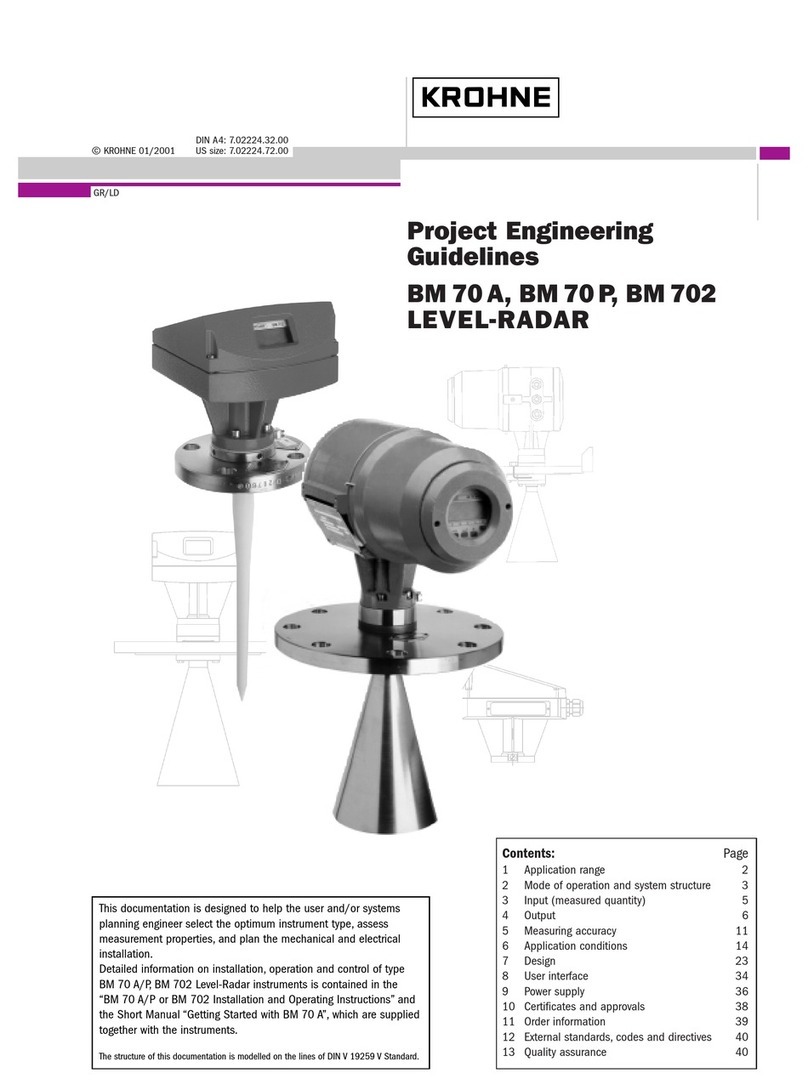
KROHNE
KROHNE BM 70 A operating instructions
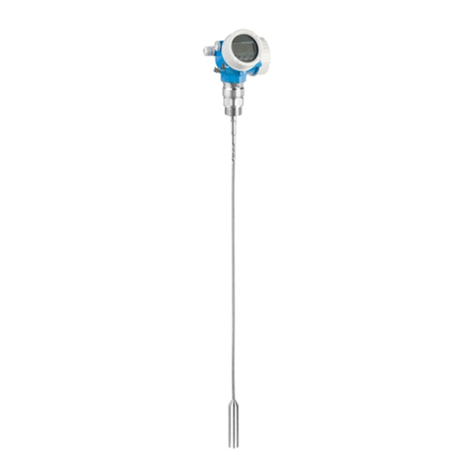
Endress+Hauser
Endress+Hauser Levelflex FMP56 operating instructions

Kustom Signals
Kustom Signals Ontario Falcon HR quick start guide
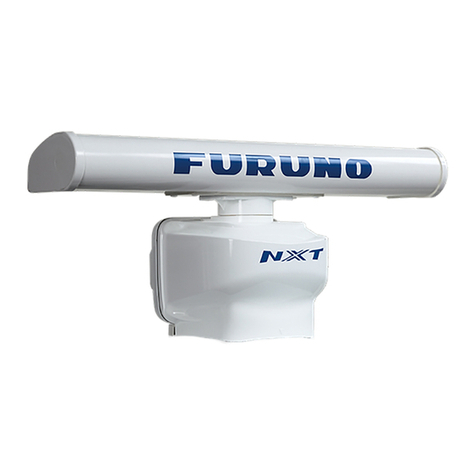
Furuno
Furuno DRS6A-NXT installation manual
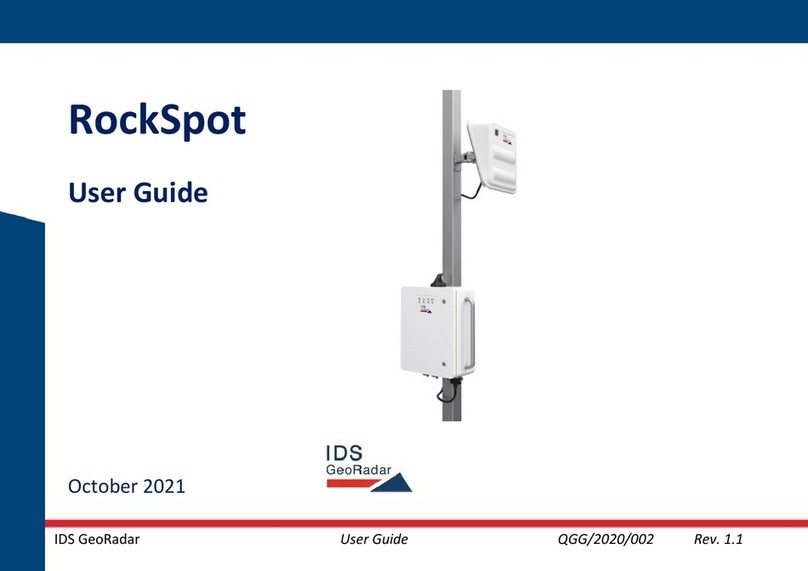
IDS GeoRadar
IDS GeoRadar RockSpot user guide
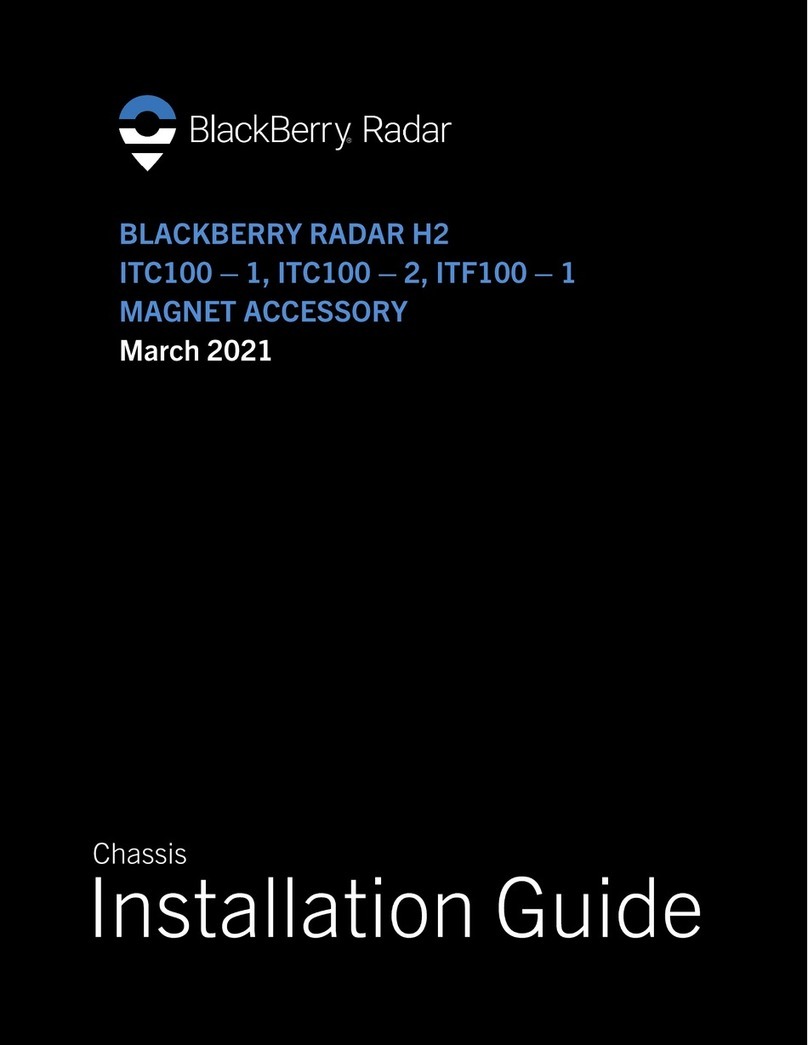
Blackbe;rry
Blackbe;rry ITC100-1 installation guide
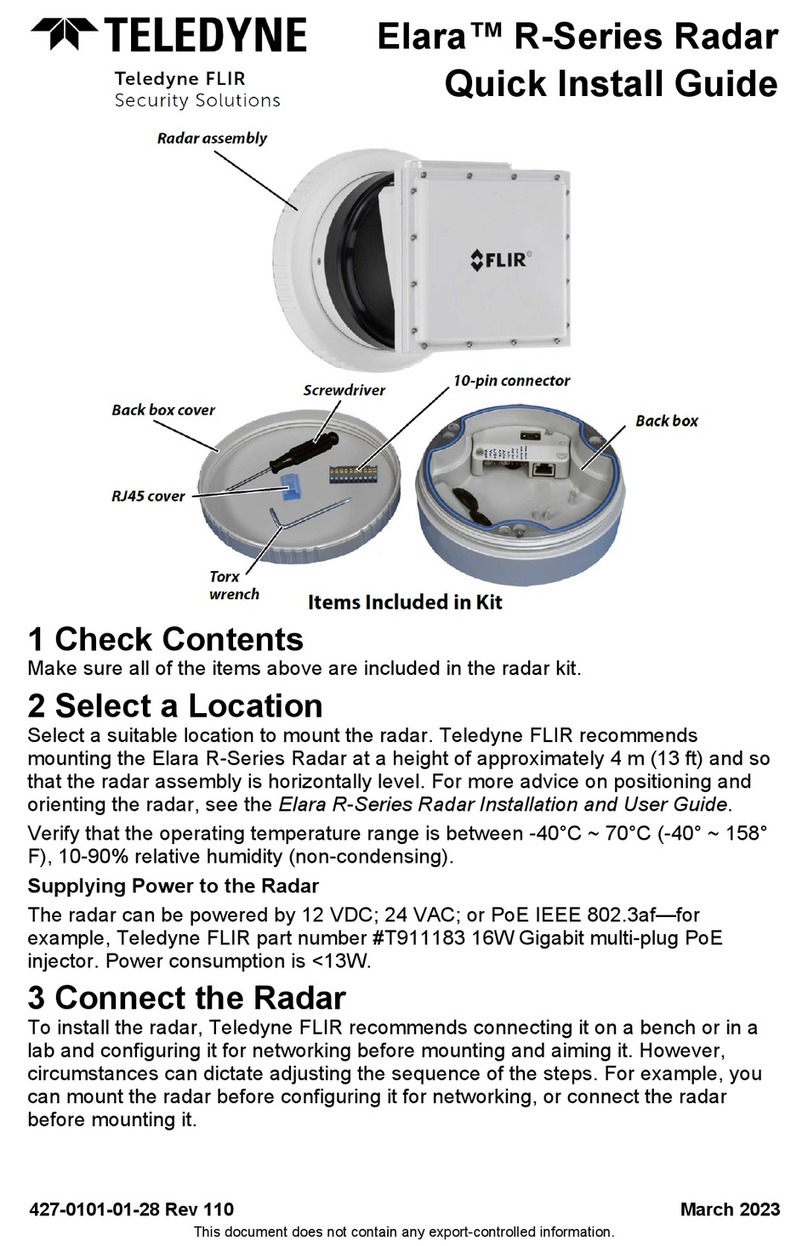
Teledyne
Teledyne FLIR Elara R Series Quick install guide
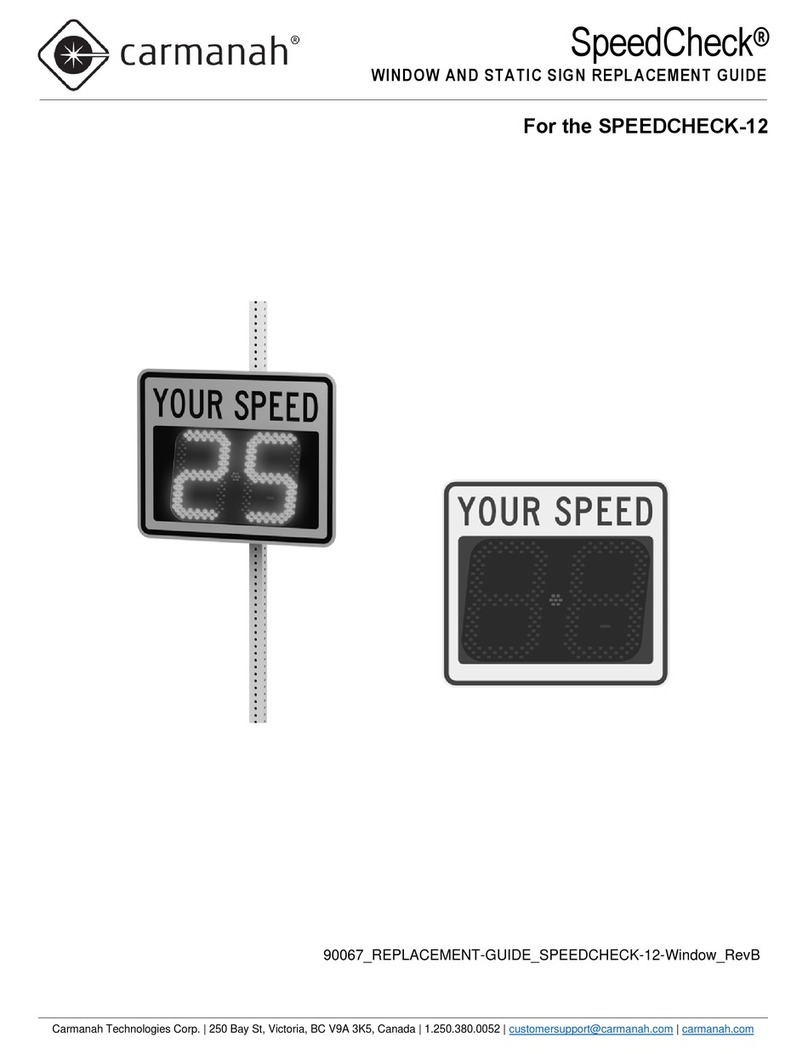
Carmanah
Carmanah SPEEDCHECK Replacement guide
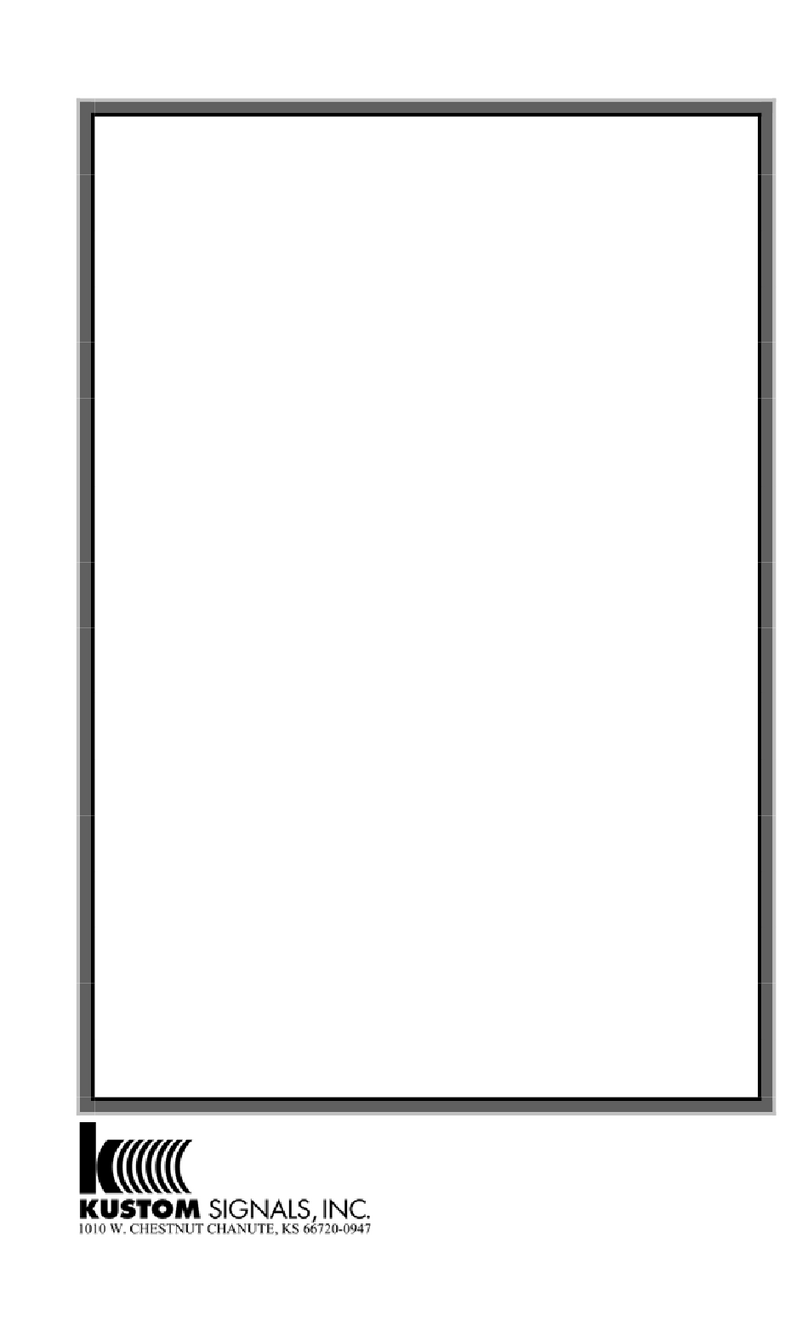
Kustom Signals
Kustom Signals Golden Eagle II Operator's manual

SAW D2L
SAW D2L Valentine One Gen2 owner's manual

Simrad
Simrad CA34 manual
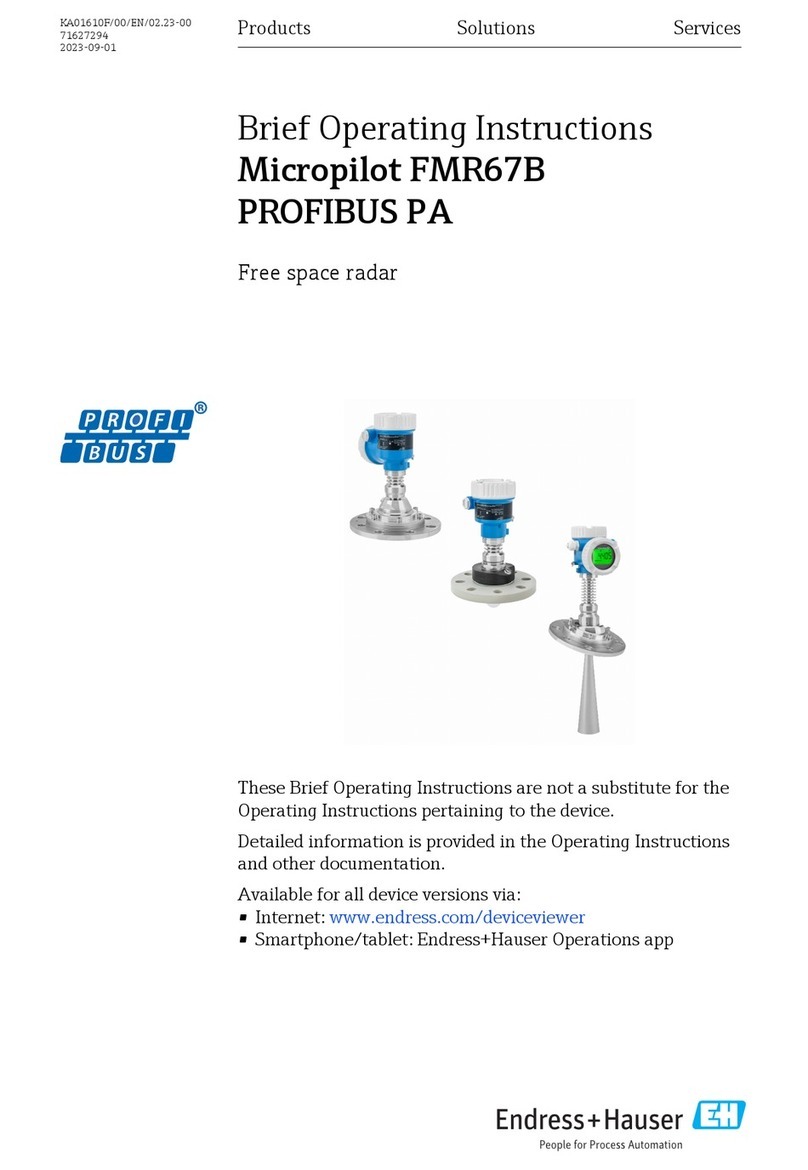
Endress+Hauser
Endress+Hauser Micropilot FMR67B Brief operating instructions


